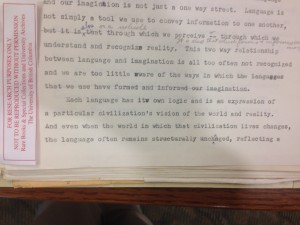Hello fellow classmates,
Last week we spent our Astu class at the Rare books and Special Collections section of Irving K. Barber Learning Center. Here, our guide explained to us how this specific section of the library works, what it contains and how can we find collections or “fonds” for researches and papers. After this brief but thorough explanation, our guide had disposed many folders on the tables in front us that are part of Joy Kogawa’s “fond” and we were allowed to read through them and take notes and/or pictures of the content. While I was reading Kogawa’s many drafts and notes about her novel Obasan, I came across a draft of a section of her novel that talked about language being used as a tool. This statement made me think about a sociology lecture, that we had not too long ago, about symbolic interaction and how it involves the cooperation of thinking and language. The former is “internalized language” (Sherrie Dilley lecture 8), in other words is like having a conversation with yourself, while the latter includes symbols that have a basic universal meaning that can be shared with mostly everyone. This use of language could be linked to how Kogawa uses it in her novel and how she connects it with silence. Silence plays a critical role in Obasan because it is a common characteristic among the main character’s family members. Since this novel talks about the discrimination of Japanese-Canadians during World War II, Kogawa wants to explain how hard it is to talk about this event and how people preferred to keep what they had to go through silenced. In the paper that I found in one of the folders, Kogawa argues that “we are too little aware of the ways in which the languages that we use have formed and informed our imagination” (Kogawa’s Fond). In other words Kogawa is arguing that even if it is common knowledge to talk about a traumatic event, the person, in this case is an entire community, finds it very hard to open itself to someone else. This practice would bring to surface all the events that the person is trying to forget and, sometimes, to disassociate with.
This argument about silence versus wording are fears, made me think of a discussion during one of our Astu lectures, about what should be remembered and what should be forgotten. How can we know for sure what it is worth to be shared with the public, without being judged by the listeners.
Work Cited:
Kogawa, Joy. Some Random Thoughts from a Novel in Progress of Obasan. n.d. ms. 8-2. Joy Kogawa fonds. University of British Columbia Library Rare Books and Special Collections. Vancouver Canada

Sherrie Dilley (2015) .Theoretical Frameworks of Sociology [PowerPoint slides]. Retrieved from: https://connect.ubc.ca/webapps/blackboard/execute/displayIndividualContent?mode=view&content_id=_3128065_1&course_id=_69332_1